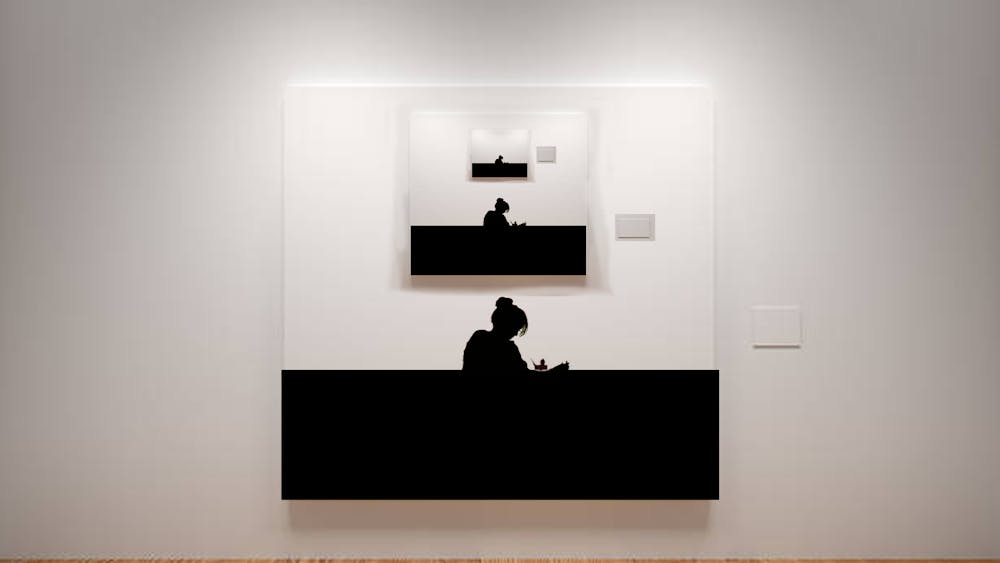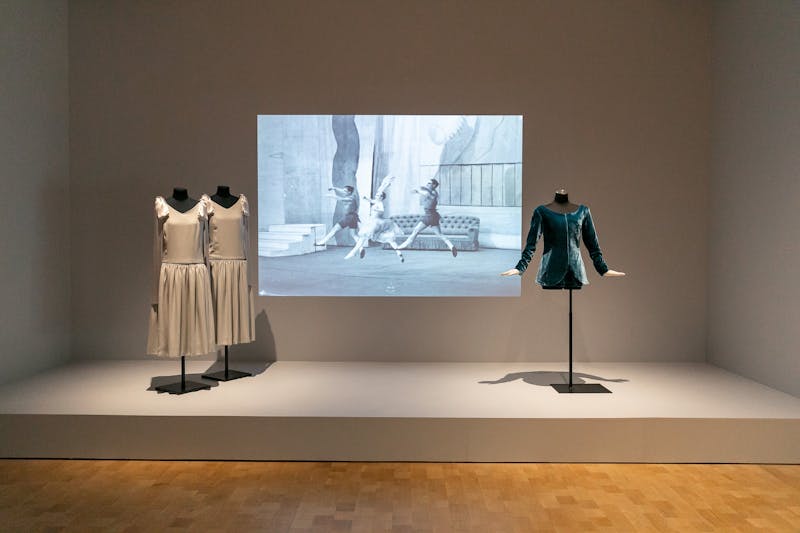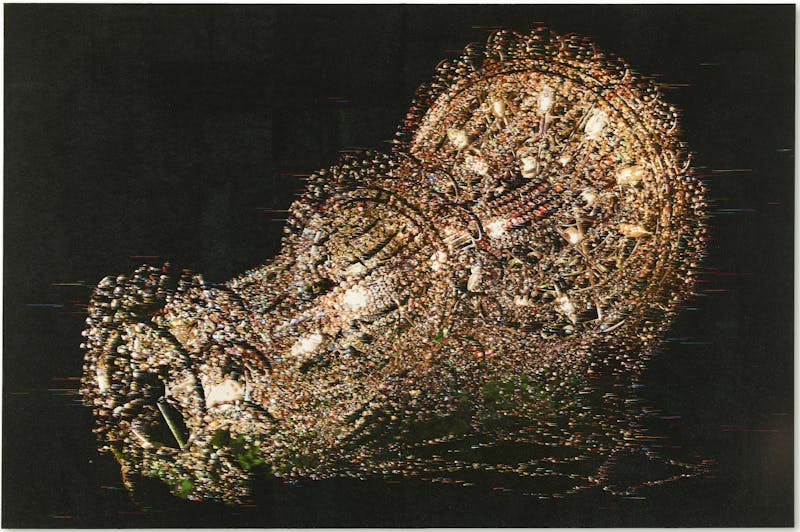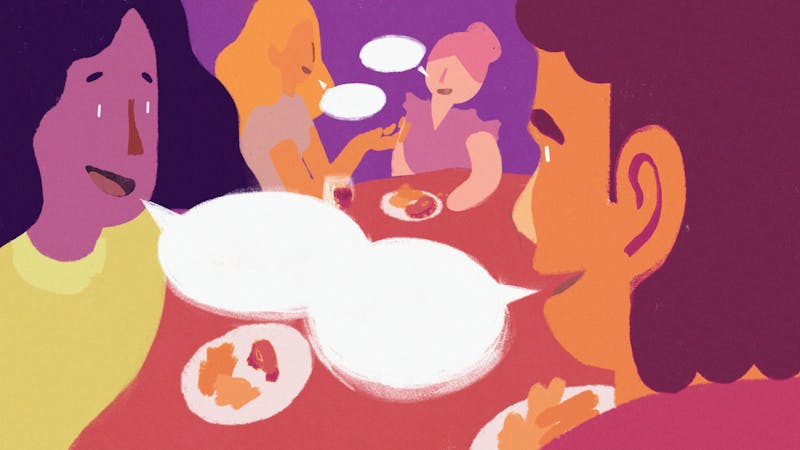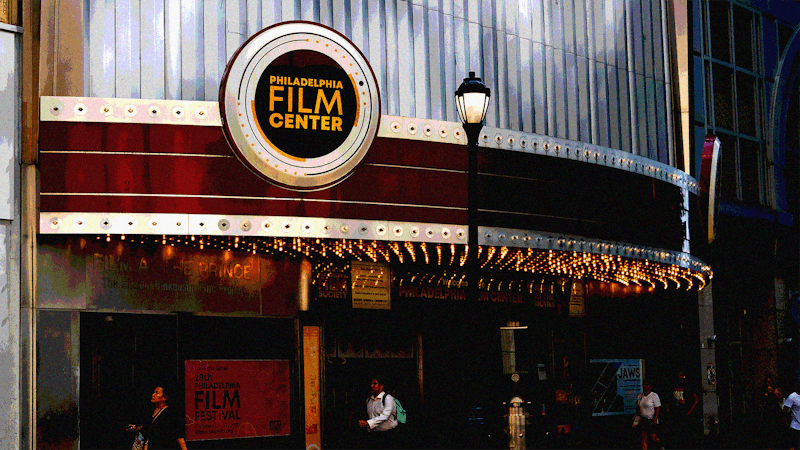It all began with picking my little sister up from a museum camp. Part of the privileges of being home for the summer is the duty of providing the rides necessary in my public transportation–less hometown of Houston. While waiting for my passenger, I meandered through the halls to find the museum's latest art exhibition: Artists on Site. After tugging on the locked door (and double checking that it wasn’t actually a “pull”), I began to walk away when a young woman in her twenties unlocked the door to let me in.
“Sorry, I usually keep it locked so I can give people the spiel on the exhibition when they come in,” she says, opening the door. Then she walked me into a space that resembled more of a studio than a gallery, a half–finished painting on the table, blue tape on the walls, and a couch in the corner.
Asia Society Texas, located in the Houston Museum District, is one of 16 Asia Societies across the globe and among the only three branches with a physical building. The Asia Society Texas Center is dedicated to performances, community events, and educational initiatives, like summer camps. They’ve hosted movie nights on their front lawn (including my all time favorite, Bend in Like Beckham) and night markets with street food and Sumo wresting (once my friends and I showed up on the wrong day, and wondered how we accidentally ended up at a Bar Mitzvah). All year long, they host seasonal art exhibitions to showcase the work of artists of color, including their current exhibition Artists on Site Series 4, where they host the artists as well.
Artists on Site Series 4 (AOS S4) is the fourth iteration of the an experiential exhibition where process and presentation are intertwined as artists in residency transform traditional galleries into their own studios. The four artists participating in the current exhibition were selected by a board that included former participants of AOS and local art curators, receiving in turn a stipend and dedicated creative space from July 27 to Aug. 27.
Selected creatives get the chance to develop and exhibit their art in an evolving, public–facing environment that pays homage to process of art as much as the final piece. As a result, Artists On Site transcends the typical gallery, presenting art in the state of perpetual progress and showcasing the artist even before the art itself.
The first room is in the gallery is dedicated to Alexis Pye, a multidisciplinary painter whose work expresses the nuances of the Black body “to evoke playfulness, wonder, and blackness, as well as the joys amidst adversity.” Originally from Michigan, Pye relocated to study at the University of Houston and has displayed her work in galleries across the city. Her studio evokes a feeling of home, with a yellow couch and table of art books she encourages visitors to sit at and read. On the far end of the room is a wall full of paintings that she warns are still wet, depicting landscapes and a Black family.
Pye notes that for her, beyond just an experiential exhibition, AOS offers a new setting to create art. At home, she lacks the amount of space afforded in this large gallery, and is thus enthused to be able to experiment with larger paintings.
As I looked around, Pye sat at her desk to sketch a geometric figure. When asked what she was drawing, she confides, “You know that Washateria in Montrose?”
I did, in fact, having worked in a coffee shop just down the street. Pye was painting a passerby, someone I may have well seen on one of my many rendezvous for a lavender latte. Suddenly, the faceless figure, abstract and distant, became rooted concretely in the city I call home.
The next space is dedicated to Farima Fooladi, a Houston transplant from Iran who currently teaches art in the city as well. Fooladi ignores the distinction between gallery and studio, canvas and wall. Instead, she takes previously completed pieces and places them on walls in order to paint around them, transforming the entire room into a piece of art with the viewer standing in its midst. One corner of her room is dedicated to a painting of a pool, a motif from her childhood before swimming pools were transformed into less controversial gardens during the Islamic Revolution.
When I entered Fooladi’s studio/gallery, an elderly woman was engrossed in conversation with her, transfixed by the artist as well as the art. “You're so beautiful!” she shouts back as she leaves.
While Artists on Site offers a unique space to connect with art, it also raises the question of who exactly is on display—the art, or the artist. As the title suggests, it is the artists themselves who give the exhibition its uniqueness: on one hand, it’s simply an open studio; Fooladi working from ten a.m. to three or five p.m. while the exhibition is quiet and empty. On the other hand, an artist's intimate processes and drafts are peered at by strangers all throughout the exhibition's open hours, open and vulnerable to dissection by voyeuristic audiences. For five weeks, artists are inseparable from their art.
Another space is dedicated to Naomi Kuo, a Taiwanese–American mixed media and social practice artist. Kuo's space is interactive, with free plant seeds to take, space to draw your own reflections, and foldable chairs snug in a corner, inviting you to read her zines.
A community activist through art, much of Kuo's artwork exists in the experimental. Booklets record art tours where the art itself is comprised of peoples' memories in a city. Diverging from the more traditional techniques of her contemporaries, Kuo draws from her experience as a woman of color to create art based in nature and community. Much of the space is taken up by a gigantic quilt made of squares with hand–written messages for social praxis.
A visitor shares with Kuo a picture on her phone of a quilt made by a family member, noting that she had won a local quilting competition. Kuo exclaims her awe.
For artists, Asia Society Texas’ Artists on Site poses a unique opportunity to intimately connect with audiences and hear firsthand the connections and meanings viewers derive from their work. The age old debate of who determines an artwork's meaning always ping–pongs between the creator or the consumer. At AOS, both engage in conversation to create shared meaning and experience. Art is not static, but a dynamic part of human connection.
While each artist's studio carries its quirks, none of them contain index cards outlining the interpretations and origins of the art pieces on the walls. Why? You can simply ask the artist, who might be working on a piece at their makeshift desk or already talking to another curious visitor.
No longer are you left standing in front of an abstract piece left to ponder whether the yellow symbolizes new life or just yellow. Instead, you turn to the artist and ask them, “Why did you use yellow?” And then tell them, of course, that yellow is your favorite color.
